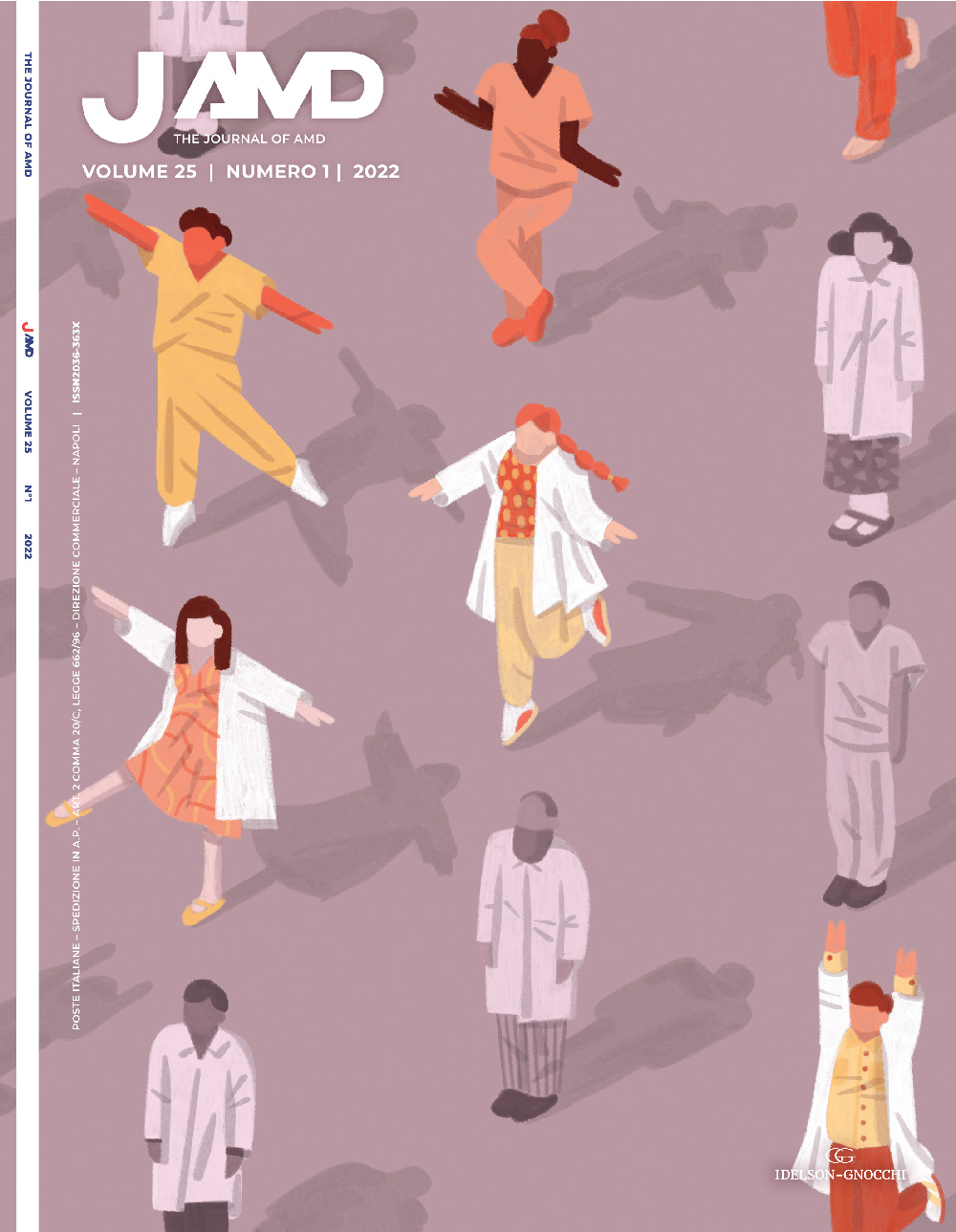Editorial
Let’s not waste any more time!
JAMD 2022;25(1):4-5
Original articles
Management of patients with heart failure and type 2 diabetes
JAMD 2022;25(1):6-13
The management of patients with cardiometabolic diseases is particularly complex and involves multiple professionals. Cardiologists and diabetologists, the coordinators of this process, should cooperate in the implementation of a joint treatment and care plan. Based on these premises, a group formed by ARCA (Regional Association of Ambulatory Cardiologists) cardiologists and AMD (Association of Diabetes Physicians) diabetologists, operating in Campania, was set up to define the critical points and create shared diagnostic and therapeutic processes. The document reviews the current evidence and gathers the opinions of the group regarding the identification of patients at higher risk of diabetes and/or heart failure and the management of patients with a known diagnosis of diabetes mellitus and heart failure.
KEYWORDS diabetes; heart failure; cardiovascular risk.
The therapeutic inertia in T2 Diabetes management during Covid-19 pandemic
JAMD 2022;25(1):14-22
The COVID-19 pandemic has profoundly changed the care and management of chronic non-communicable diseases, not least diabetes mellitus. As part of the Annali AMD, an in-depth analysis was conducted on the effects of the health emergency originating from the epidemic spread of SARS-CoV-2 on Italian T2 diabetes. The data extracted from the computerized diabetes file of all patients who presented a pharmacological prescription regardless of the contextual weight and blood pressure measurement were analyzed in order to also include those who had been followed in 2020 yrs by remote with telemedicine or television systems, vs 2019 yrs. Despite the extreme difficulty of the first months of the lockdown, the total number of patients followed in presence and by remote in 2020 was only 0.8% lower than in 2019. In 2020 there was an increase in prescription (net of the quarter). MarchJune 2020) of cardio-nephro protective drugs (SGLT2i and GLP1RA) compared to a reduction of that of secretagogues. However, the average level of Hba1c worsened, albeit slightly, in 2020 and there were many difficulties in implementing the therapy even in subjects with elevated HbA1c where there was a further delay in the initiation of insulin therapy. Complications have also been investigated to a lesser extent due to the obvious consequences of the significant downsizing of access to health facilities for clinical and laboratory tests. Ultimately, despite the efforts of the Italian diabetes community to continue taking care of people with diabetes with the various means made available, the COVID-19 pandemic represented a further reason for the worsening of the therapeutic inertia. At the same time, it provided the opportunity to experiment with telemedicine / television systems that will have to represent, in an adequate technological and regulatory context, in the immediate future, additional tools available to encourage an increasingly global care of the person with diabetes.
KEYWORDS type 2 diabetes mellitus; therapeutic inertia; pandemia; Covid 19; telemedicine; SGLT2i; GLP1RA; insulin.
Telemedicine between definitions and communicative implications
JAMD 2022;25(1):23-30
Telemedicine was born from the encounter between medicine and telecommunications and is part of eHealth. It consists of the “practice of medicine without the usual physical confrontation between doctor and patient”. In 1997, the WHO defined it as “The provision of health services when distance is a critical factor, for which it is necessary to use information and telecommunications technologies by operators”. Covid-19 has speeded up the use of the virtual both in private and professional contexts. This has proved to be very useful in medical practice, in particular in psychological, dietary and chronic support, although it is still discriminating for the poorly digitized categories. The result was a legislative ferment starting from the European Union which issued a Communication no. 689/2008, to promote telemedicine and in Italy the National Institute of Health (ISS) has set up a technical table to draft national guidelines. The quality of the relationship also plays a fundamental role in telemedicine. The relationship with the patient online, while maintaining aspects in common with the relationship in presence, shows peculiar traits that require ad hoc training. At the Melegnano-Martesana Healthcare Company we carried out a training course in 2020 consisting in 8 meetings of 2 hours each with subsequent supervision. Verbal, non-verbal, paraverbal and care of the setting are revisited at the service of the patient and of the professional to cure and to care the patient with respect for themselves.
KEYWORDS telemedicine; eHealth; relationship; training course; online.
International Symposium Facing the challenge of clinical inertia in 2022
Overcoming therapeutic inertia: ADA perspective
JAMD 2022;25(1):31-33
Good outcomes are obtained with early glycemic control, as shown by the UK Prospective Diabetes Study (UKPDS), but the legacy benefits continue ten years after the study ending, and are also present for lipid and blood pressure management. The ADA and EASD consensus report now has, for the first time, evidence-based recommendations: among them, on a blue circle on the top of the flowchart, it is recommended to “avoid clinical inertia”, and “to reassess and modify clinical treatment regularly, every 3-6 months”(1).
International Symposium Facing the challenge of clinical inertia in 2021
How can we overcome clinical inertia? The EASD vision
JAMD 2022;25(1):34-36
International Symposium Facing the challenge of clinical inertia in 2022
Clinical inertia in Italy and clinical practice
JAMD 2022;25(1):37-39
What could it be the importance of a multi-scientific alliance in defeating therapeutical inertia?
JAMD 2022;25(1):40-42
Documento congiunto AMD - SID - SIEDP
Type 1 diabetes mellitus therapy. Guideline by Associazione Medici Diabetologi (AMD), Società Italiana di Diabetologia (SID) and Società Italiana di Endocrinologia e Diabetologia Pediatrica (SIEDP)
JAMD 2022;25(1):45-54
Surveys
Knowledge; know-how; skills to be able to live with chronicity, care for it, and cure it. An AMD project to help clinicians overcome therapeutic inertia. Results of the web survey among AMD members
JAMD 2022;25(1):55-63
The aim of this study was to examine diabetologist’s behaviour in terms of therapeutic inertia, taking into account the numerous barriers encountered in the current clinical management models (burocratic aspects, lack of time to dedicate to patients, and others), while focusing on emotional and cultural aspects that could emerge during clinical practice.
The AMD (Associazione Medici Diabetologi) sent a web link to access a 19-items online questionnaire to all their associates. The first part of the questionnaire was finalized to describe the sample of diabetologists involved in this project (age, sex, working context, etc.), while the second part analyzed their attitude regarding therapeutic inertia.
Ninety-four diabetologists (66% women, 34% men), age range 30-70 years, uniformly distributed in the national territory (37% South, 36% North and 27% Center) participated to the survey. Diabetologists participating to the study had a long-standing clinical experience in diabetes (81% of them had a professional activity lasting >10 years), 51% of them were employed in hospital, 37% in territorial outpatient clinics and 10% in private practice only. Answers to the survey showed the presence of therapeutic inertia in their clinical practice, and that it is related to multiple causal factors, including the complexity of the disease and its multiple and complex therapeutic approach, all aspects that have been exacerbated by the recent COVID-19 pandemic.
Besides their clinical competence in the management of the disease, clinicians involved in diabetes need a specific support aimed to ameliorate their decisional aspects and their relationships with patients, in order to capture patients’ needs and to suggest them the most suitable, efficacious and safe therapeutic approach leading to a real personalization of the cure.
KEYWORDS diabetes mellitus; new hypoglycemic agents; therapeutic inertia.
Attività dei gruppi
Perioperative management of diabetic patients undergoing elective and emergency surgery
JAMD 2022;25(1):64-74
Patients with known or undiagnosed diabetes frequently undergo surgery. Diabetes and unknown origin hyperglycemia frequently complicate surgical procedures, thus leading to a 45% higher length of stay (LOS) and a 50% increase in patients’ mortality, in addition to higher incidence of infectious complications, myocardial infarction, respiratory failure, stroke and acute renal failure.
Hyperglycemia is often not properly corrected due to: healthcare professionals’ lack of sensitivity vs adequate glycemic control advantages on surgical treatment’s outcome; presence of other than diabetes care priorities; the fear of hypoglycemia, which is one of the main barriers in achieving appropriate glycemic targets.
It is absolutely a priority the creation of well-structured care paths whether pre, intra and post-surgery aiming at reducing negative outcomes via careful assessment of good glycemic control, knowledge of diabetic complications and comorbidities, and appropriate peri and post-surgery therapeutic management.
Since 2014 the Diabetes and Inpatient Group of AMD, in collaboration with the Italian Society of Surgery, has developed various recommendations for the evaluation of diabetic patients undergoing elective surgery; they focused on the identification of anesthetic risks, on the definition of the best personalized diabetic treatments, on the reduction of surgery’s related risks such as the type of intervention (major or minor), thus ensuring continuity of the health care plan even at discharge. In this document, we nonetheless paid attention to the most recent guidelines on diabetes and surgery.
KEYWORDS inpatient diabetes; elective surgery; emergency surgery; perioperative pathway
Documento congiunto AMD – SID – SIEDP
Le nuove linee guida sulla terapia del diabete di tipo 1. La rivoluzione continua!
New guidelines on type 1 diabetes therapy. The revolution goes on!
JAMD 2022;25(1):43-44
Dalla letteratura
Intervalli di riferimento specifici per sesso e cure transgender
JAMD 2022;25(1):75-76




